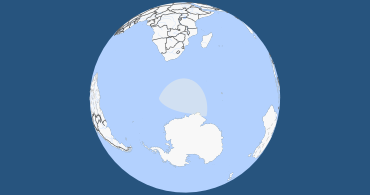The July 1 partial solar eclipse occurs only one lunation after the last partial solar eclipse. Unfortunately this eclipse is not visible for most of the world. This eclipse is the third of four partial solar eclipses that occur throughout the year.
This eclipse wasn't visible in Columbus - Which upcoming eclipses can be seen in your location?
Where the Eclipse Was Seen
Try our new interactive eclipse maps. Zoom in and search for accurate eclipse times and visualizations for any location.
Path of the Eclipse Shadow
Regions that saw, at least, a partial eclipse: Atlantic, Indian Ocean.
The partial solar eclipse on July 1, 2011, is only visible if you are on the coast of Antarctica, where the South Atlantic and Indian Oceans meet. This eclipse occurs only one month after the June 1 partial solar eclipse. The lunar penumbra briefly touches the globe off Lutzow-Holm bay, which is on the coast of Antarctica. A partial solar eclipse occurs when the moon’s shadow misses the Earth but passes very close to it.
Unfortunately, this eclipse did not pass over any major population centers
This eclipse wasn't visible in Columbus - Which upcoming eclipses can be seen in your location?
Eclipse Shadow Path
0%
>0%
The dark areas symbolize night and twilight.
When the Eclipse Happened Worldwide — Timeline
The eclipse started at one location and ended at another. The times below are actual times (in UTC) when the eclipse occurred. This calculation uses a Delta T value of 66.5 seconds.
| Eclipse Stages Worldwide | UTC Time | Local Time in Columbus* |
|---|---|---|
| First location to see the partial eclipse begin | Jul 1 at 07:53:41 | Jul 1 at 3:53:41 am |
| Maximum Eclipse | Jul 1 at 08:38:24 | Jul 1 at 4:38:24 am |
| Last location to see the partial eclipse end | Jul 1 at 09:22:52 | Jul 1 at 5:22:52 am |
* These local times do not refer to a specific location but indicate the beginning, peak, and end of the eclipse on a global scale, each line referring to a different location. This eclipse isn't visible in Columbus.
Upcoming eclipses visible in Columbus
Next Partial Solar Eclipse will be on Nov 25, 2011
Eclipse calculations usually accurate to a few seconds
Countries Where the Eclipse Is Visible
| Country | Type | Start of Eclipse | End of Eclipse |
|---|---|---|---|
| Antarctica | Partial Solar Eclipse | 11:25 am | 2:22 pm MAWT |
All times shown in this table are local time. (Note: more than one time zone is listed.)
How Many People Can See This Eclipse?
| Number of People Seeing... | Number of People* | Fraction of World Population |
|---|---|---|
| Any part of the eclipse | - | - |
* The number of people refers to the resident population (as a round number) in areas where the eclipse is visible. timeanddate has calculated these numbers using raw population data provided by the Center for International Earth Science Information Network (CIESIN) at Columbia University. The raw data is based on population estimates from the year 2000 to 2020.

An Eclipse Never Comes Alone!
A solar eclipse always occurs about two weeks before or after a lunar eclipse.
Usually, there are two eclipses in a row, but other times, there are three during the same eclipse season.
This is the third eclipse this season.
First eclipse this season: June 1, 2011 — Partial Solar Eclipse
Second eclipse this season: June 15, 2011 — Total Lunar Eclipse

